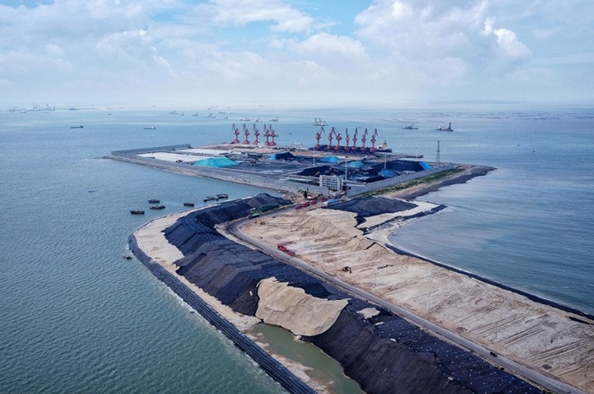By Pang Geping, Zheng Yi, People's Daily
The construction of the Pinglu Canal, one of the major projects of China's new western land-sea corridor, kicked off on Aug. 28.
The canal, located in south China's Guangxi Zhuang autonomous region and stretching 135 kilometers from Xijin Reservoir in Hengzhou to Luwu township in Lingshan county, is the first canal flowing into sea constructed by China since 1949.
The Pinglu Canal will reach the Beibu Gulf via the Qinjiang River.
It is reported that the canal will be navigable to 5,000-ton ships. The construction includes the excavation of waterways, navigation hubs, cross-canal facilities and auxiliary projects. The canal is mainly used for shipping, and other functions include water supplies, irrigation, flood protection and aquatic ecosystem improvement.

Upon completion, the Pinglu Canal will become the shortest, the most economical and the most convenient route to the sea for Guangxi and even southwest China and west China.
The canal is expected to shorten the voyage of goods entering the Beibu Gulf by around 560 kilometers, and save more than 5.2 billion yuan ($753.2 million) in transportation costs on an annual basis for regions along the new western land-sea corridor.
The canal will significantly improve the efficiency and capacity of regional transportation, enhance the connection between rivers and the sea, and inject strong impetus into coordinated regional development and opening up.
The canal will create favorable conditions for the regions along the middle and upper reaches of the Xijiang River to develop seaward economy, receive industries relocated from the Pearl River Delta, and develop primary commodities.

It will boost the economic development of Guangxi's capital Nanning, as well as Qinzhou, and drive the innovative and open development of other cities in the autonomous region such as Baise, Liuzhou, Laibin and Guigang.
As a major project serving the Belt and Road Initiative and assisting the building of a new development paradigm, the Pinglu Canal can further optimize the structure of the new western land-sea corridor, enhance transportation capacity, and maintain stability of industrial and supply chains.
Besides, the canal will better integrate Guangxi and southwest China into the building of a China-ASEAN community with a shared future.
"At present, the Beibu Gulf still enjoys huge potential in cargo handling capacity. The completion of the Pinglu Canal will lead to better navigation and facilitate the development of seaward economy," said Ren Ningwu, head of the Pinglu Canal office of the Beibu Gulf Port Group.

The shortened voyage will not only expand the freight volume of Guangxi, but also make Guangxi a hub from which western provinces export their products, thus further promoting the economic development of Guangxi and China's western development drive.
Forming a multimodal transport system with roads and railways, the canal will make it possible for Guizhou and Yunnan provinces in southwest China to send their coals and nonferrous metals to the Beibu Gulf faster and then export them to ASEAN countries. Meanwhile, aquatic products, nuts and fruits from ASEAN countries can also enter China through the Beibu Gulf and be transported to west China via the multimodal transport system.
In the first half of 2022, 4,132 sea-rail combined train trips were made on the new western land-sea corridor, up 42 percent year on year. In the same period, the cargo throughput of the Beibu Gulf port expanded five percent from a year ago to 182 million tons, and the port handled over 3.16 million twenty-foot equivalent units, up 21 percent year on year.


